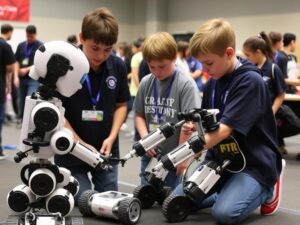Robotics competitions aren’t just about letting kids unleash their creativity; they’re about strengthening problem-solving skills and fostering cooperation. They provide a solid foundation for innovation and develop the competencies needed for the future. They create an experiential, interactive STEM learning experience.
What are robotics competitions?
Robotics competitions bring together students of various levels to design, program, and build robots capable of performing tasks, from simple navigation through a maze to complex operations like rescuing people in disaster scenarios. These competitions offer an engaging and entertaining way to learn STEM and gain valuable skills.


Why are robotics competitions important?
Robotics competitions are immensely important for research and encourage students to pursue STEM careers. They prepare students to thrive in a technogenic world. Here’s what they build:
- Problem-solving: Students identify problems, design solutions, and create models.
- Critical Thinking: Students assess, devise alternatives, and make informed decisions.
- Teamwork: Students learn leadership, teamwork, and communication through collaboration.
- Creativity: Students develop imaginative and creative solutions.
- Technical Skills: Students acquire applied engineering, programming, and robotics skills.
Types of Robotics Competitions
There’s a robotics competition for everyone, varying in difficulty, age group, and focus:
- FIRST Robotics Competition (FRC): High school students design and build large, complex robots for challenging games. FRC emphasises gracious professionalism, leadership, and collaboration.
- FIRST Tech Challenge (FTC): For teens, using smaller, lighter robots. FTC focuses on strategy, design, and collaboration, serving as a stepping stone to FRC.
- FIRST LEGO League (FLL): For elementary and middle school students. Teams use LEGO MINDSTORMS robots to solve real-world problems, incorporating robotics, presentations, and research.
- VEX Robotics Competitions: Various competitions from university to elementary school. VEX robots are functional and versatile. Competitions emphasise engineering design and programming.
- World Robot Olympiad (WRO): A global competition for students aged 8–25. Teams work together as creative problem-solvers.
Advantages of Robotics Competitions
Participating in robotics competitions offers numerous benefits:
- Enhance STEM Skills: Practical learning in science, technology, engineering, and mathematics.
- Acquire problem-solving skills: developing innovative solutions to real-world problems.
- Acquire Teamwork and Communication Skills: Essential skills developed through collaboration.
- Gain confidence and self-esteem: Success in projects and competitions builds confidence.
- Preparation for Future Careers: Developing cutting-edge technical knowledge in STEM.
- Network Building: Connecting with peers, mentors, and professionals.


Participation in Robotics Competitions
Ready to jump in? Here’s how:
- Team Planning: Form a robotics team. Many schools have clubs, or you can check with competition websites.
- Team Building: If a team doesn’t exist, create one! You’ll need a coach, materials, and participants. Competition organisers often provide resources for new teams.
- Utilise Online Resources: Competition websites are invaluable tools, offering information about rules, resources, and registration.
Robotics Competitions: The Hidden Key to Innovation
Robotics competitions are more than just games; they unlock innovation and develop essential 21st-century skills. They provide practical experience, build confidence, and offer a competitive edge in STEM education. They teach innovation, problem-solving, and teamwork. They are a passport to the world of innovation.
The Future of Robot Competitions
The future of technology is intertwined with the future of robotic competitions. Expect more complex tasks, advanced robots, and a greater emphasis on artificial intelligence and machine learning. These competitions will play an increasingly important role in preparing students for the future workforce.
Resources for Robotics Competitions
Explore these resources:
- FIRST Robotics
- VEX Robotics
- World Robot Olympiad
- NASA Robotics Competitions
The Impact of Robotics Competitions on STEM Education
Robotics competitions are a powerful tool for shaping the future of STEM education. Studies show that participants demonstrate improved STEM learning and performance. They bring learning to life through hands-on, interactive experiences.
Robotics Competitions and 21st-Century Skill Acquisition
Beyond STEM, these competitions develop crucial 21st-century skills: critical thinking, problem solving, creativity, teamwork, and communication. They provide hands-on, experiential learning in these essential areas.
Sample Examples of Innovative Robotics Competition Projects
Students have developed incredible projects, including:
- Rescue robots for disaster relief
- Medical procedure robots
- Space exploration robots
- Robots for assisting individuals with disabilities
- Robots for industrial automation
These projects showcase the potential of robotics and the ability of students to make a real-world impact.
The Role of Mentors in Robotics Competitions
Mentors are crucial, providing motivation, inspiration, and guidance. They can be engineers, teachers, scientists, or STEM professionals. They help students learn about robotics, prepare for competitions, and serve as role models.
The Role of Diversity and Inclusion in Robotics Competitions
Diversity and inclusion are essential. Efforts should be made to encourage participation from under-represented groups, including minorities, women, and marginalised communities.
Robotics Competitions: A Global Phenomenon
These competitions are international, bringing together students from around the world. They provide opportunities for cultural exchange and foster global awareness.
The Future of Work and the Role of Robotics Skills
As automation and robotics reshape the workplace, demand for robotics skills will increase. Students with robotics competition experience will have a significant advantage.
Conclusion: Robotics Competitions: An Investment for the Future
Robotics competitions are an investment in the future. They provide students with the experiential, theoretical, and practical skills they need to succeed in the 21st century. 1 By encouraging participation, we are building a more technological and innovative future. These competitions aren’t just about robots; they’re about shaping future leaders, innovators, and problem-solver







































Leave a Review